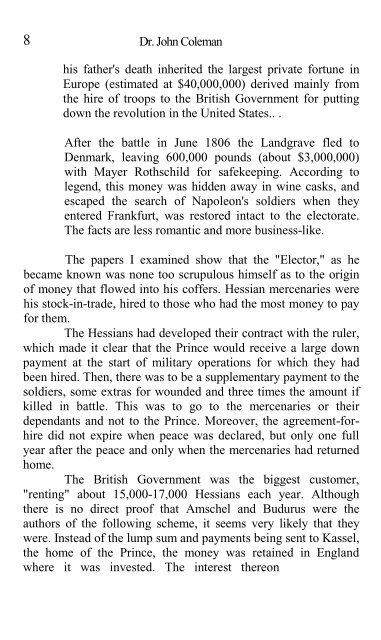coleman-the-rothschild-dynasty
coleman-the-rothschild-dynasty
coleman-the-rothschild-dynasty
Create successful ePaper yourself
Turn your PDF publications into a flip-book with our unique Google optimized e-Paper software.
8 Dr. John Coleman<br />
his fa<strong>the</strong>r's death inherited <strong>the</strong> largest private fortune in<br />
Europe (estimated at $40,000,000) derived mainly from<br />
<strong>the</strong> hire of troops to <strong>the</strong> British Government for putting<br />
down <strong>the</strong> revolution in <strong>the</strong> United States.. .<br />
After <strong>the</strong> battle in June 1806 <strong>the</strong> Landgrave fled to<br />
Denmark, leaving 600,000 pounds (about $3,000,000)<br />
with Mayer Rothschild for safekeeping. According to<br />
legend, this money was hidden away in wine casks, and<br />
escaped <strong>the</strong> search of Napoleon's soldiers when <strong>the</strong>y<br />
entered Frankfurt, was restored intact to <strong>the</strong> electorate.<br />
The facts are less romantic and more business-like.<br />
The papers I examined show that <strong>the</strong> "Elector," as he<br />
became known was none too scrupulous himself as to <strong>the</strong> origin<br />
of money that flowed into his coffers. Hessian mercenaries were<br />
his stock-in-trade, hired to those who had <strong>the</strong> most money to pay<br />
for <strong>the</strong>m.<br />
The Hessians had developed <strong>the</strong>ir contract with <strong>the</strong> ruler,<br />
which made it clear that <strong>the</strong> Prince would receive a large down<br />
payment at <strong>the</strong> start of military operations for which <strong>the</strong>y had<br />
been hired. Then, <strong>the</strong>re was to be a supplementary payment to <strong>the</strong><br />
soldiers, some extras for wounded and three times <strong>the</strong> amount if<br />
killed in battle. This was to go to <strong>the</strong> mercenaries or <strong>the</strong>ir<br />
dependants and not to <strong>the</strong> Prince. Moreover, <strong>the</strong> agreement-forhire<br />
did not expire when peace was declared, but only one full<br />
year after <strong>the</strong> peace and only when <strong>the</strong> mercenaries had returned<br />
home.<br />
The British Government was <strong>the</strong> biggest customer,<br />
"renting" about 15,000-17,000 Hessians each year. Although<br />
<strong>the</strong>re is no direct proof that Amschel and Budurus were <strong>the</strong><br />
authors of <strong>the</strong> following scheme, it seems very likely that <strong>the</strong>y<br />
were. Instead of <strong>the</strong> lump sum and payments being sent to Kassel,<br />
<strong>the</strong> home of <strong>the</strong> Prince, <strong>the</strong> money was retained in England<br />
where it was invested. The interest <strong>the</strong>reon


